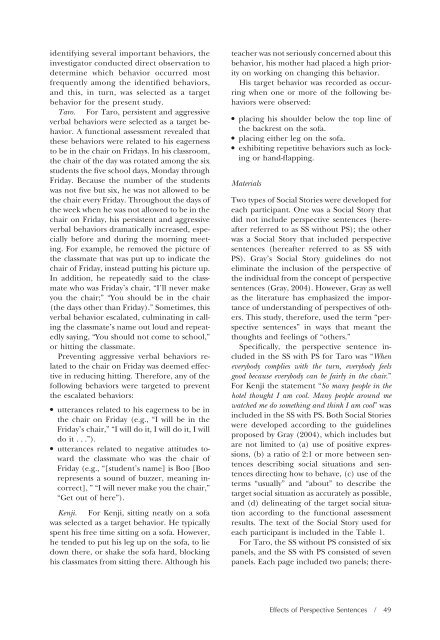Download the Journal (PDF) - Division on Autism and ...
Download the Journal (PDF) - Division on Autism and ...
Download the Journal (PDF) - Division on Autism and ...
Create successful ePaper yourself
Turn your PDF publications into a flip-book with our unique Google optimized e-Paper software.
identifying several important behaviors, <str<strong>on</strong>g>the</str<strong>on</strong>g><br />
investigator c<strong>on</strong>ducted direct observati<strong>on</strong> to<br />
determine which behavior occurred most<br />
frequently am<strong>on</strong>g <str<strong>on</strong>g>the</str<strong>on</strong>g> identified behaviors,<br />
<strong>and</strong> this, in turn, was selected as a target<br />
behavior for <str<strong>on</strong>g>the</str<strong>on</strong>g> present study.<br />
Taro. For Taro, persistent <strong>and</strong> aggressive<br />
verbal behaviors were selected as a target behavior.<br />
A functi<strong>on</strong>al assessment revealed that<br />
<str<strong>on</strong>g>the</str<strong>on</strong>g>se behaviors were related to his eagerness<br />
to be in <str<strong>on</strong>g>the</str<strong>on</strong>g> chair <strong>on</strong> Fridays. In his classroom,<br />
<str<strong>on</strong>g>the</str<strong>on</strong>g> chair of <str<strong>on</strong>g>the</str<strong>on</strong>g> day was rotated am<strong>on</strong>g <str<strong>on</strong>g>the</str<strong>on</strong>g> six<br />
students <str<strong>on</strong>g>the</str<strong>on</strong>g> five school days, M<strong>on</strong>day through<br />
Friday. Because <str<strong>on</strong>g>the</str<strong>on</strong>g> number of <str<strong>on</strong>g>the</str<strong>on</strong>g> students<br />
was not five but six, he was not allowed to be<br />
<str<strong>on</strong>g>the</str<strong>on</strong>g> chair every Friday. Throughout <str<strong>on</strong>g>the</str<strong>on</strong>g> days of<br />
<str<strong>on</strong>g>the</str<strong>on</strong>g> week when he was not allowed to be in <str<strong>on</strong>g>the</str<strong>on</strong>g><br />
chair <strong>on</strong> Friday, his persistent <strong>and</strong> aggressive<br />
verbal behaviors dramatically increased, especially<br />
before <strong>and</strong> during <str<strong>on</strong>g>the</str<strong>on</strong>g> morning meeting.<br />
For example, he removed <str<strong>on</strong>g>the</str<strong>on</strong>g> picture of<br />
<str<strong>on</strong>g>the</str<strong>on</strong>g> classmate that was put up to indicate <str<strong>on</strong>g>the</str<strong>on</strong>g><br />
chair of Friday, instead putting his picture up.<br />
In additi<strong>on</strong>, he repeatedly said to <str<strong>on</strong>g>the</str<strong>on</strong>g> classmate<br />
who was Friday’s chair, “I’ll never make<br />
you <str<strong>on</strong>g>the</str<strong>on</strong>g> chair;” “You should be in <str<strong>on</strong>g>the</str<strong>on</strong>g> chair<br />
(<str<strong>on</strong>g>the</str<strong>on</strong>g> days o<str<strong>on</strong>g>the</str<strong>on</strong>g>r than Friday).” Sometimes, this<br />
verbal behavior escalated, culminating in calling<br />
<str<strong>on</strong>g>the</str<strong>on</strong>g> classmate’s name out loud <strong>and</strong> repeatedly<br />
saying, “You should not come to school,”<br />
or hitting <str<strong>on</strong>g>the</str<strong>on</strong>g> classmate.<br />
Preventing aggressive verbal behaviors related<br />
to <str<strong>on</strong>g>the</str<strong>on</strong>g> chair <strong>on</strong> Friday was deemed effective<br />
in reducing hitting. Therefore, any of <str<strong>on</strong>g>the</str<strong>on</strong>g><br />
following behaviors were targeted to prevent<br />
<str<strong>on</strong>g>the</str<strong>on</strong>g> escalated behaviors:<br />
● utterances related to his eagerness to be in<br />
<str<strong>on</strong>g>the</str<strong>on</strong>g> chair <strong>on</strong> Friday (e.g., “I will be in <str<strong>on</strong>g>the</str<strong>on</strong>g><br />
Friday’s chair,” “I will do it, I will do it, I will<br />
do it . . .”).<br />
● utterances related to negative attitudes toward<br />
<str<strong>on</strong>g>the</str<strong>on</strong>g> classmate who was <str<strong>on</strong>g>the</str<strong>on</strong>g> chair of<br />
Friday (e.g., “[student’s name] is Boo [Boo<br />
represents a sound of buzzer, meaning incorrect],<br />
” “I will never make you <str<strong>on</strong>g>the</str<strong>on</strong>g> chair,”<br />
“Get out of here”).<br />
Kenji. For Kenji, sitting neatly <strong>on</strong> a sofa<br />
was selected as a target behavior. He typically<br />
spent his free time sitting <strong>on</strong> a sofa. However,<br />
he tended to put his leg up <strong>on</strong> <str<strong>on</strong>g>the</str<strong>on</strong>g> sofa, to lie<br />
down <str<strong>on</strong>g>the</str<strong>on</strong>g>re, or shake <str<strong>on</strong>g>the</str<strong>on</strong>g> sofa hard, blocking<br />
his classmates from sitting <str<strong>on</strong>g>the</str<strong>on</strong>g>re. Although his<br />
teacher was not seriously c<strong>on</strong>cerned about this<br />
behavior, his mo<str<strong>on</strong>g>the</str<strong>on</strong>g>r had placed a high priority<br />
<strong>on</strong> working <strong>on</strong> changing this behavior.<br />
His target behavior was recorded as occurring<br />
when <strong>on</strong>e or more of <str<strong>on</strong>g>the</str<strong>on</strong>g> following behaviors<br />
were observed:<br />
● placing his shoulder below <str<strong>on</strong>g>the</str<strong>on</strong>g> top line of<br />
<str<strong>on</strong>g>the</str<strong>on</strong>g> backrest <strong>on</strong> <str<strong>on</strong>g>the</str<strong>on</strong>g> sofa.<br />
● placing ei<str<strong>on</strong>g>the</str<strong>on</strong>g>r leg <strong>on</strong> <str<strong>on</strong>g>the</str<strong>on</strong>g> sofa.<br />
● exhibiting repetitive behaviors such as locking<br />
or h<strong>and</strong>-flapping.<br />
Materials<br />
Two types of Social Stories were developed for<br />
each participant. One was a Social Story that<br />
did not include perspective sentences (hereafter<br />
referred to as SS without PS); <str<strong>on</strong>g>the</str<strong>on</strong>g> o<str<strong>on</strong>g>the</str<strong>on</strong>g>r<br />
was a Social Story that included perspective<br />
sentences (hereafter referred to as SS with<br />
PS). Gray’s Social Story guidelines do not<br />
eliminate <str<strong>on</strong>g>the</str<strong>on</strong>g> inclusi<strong>on</strong> of <str<strong>on</strong>g>the</str<strong>on</strong>g> perspective of<br />
<str<strong>on</strong>g>the</str<strong>on</strong>g> individual from <str<strong>on</strong>g>the</str<strong>on</strong>g> c<strong>on</strong>cept of perspective<br />
sentences (Gray, 2004). However, Gray as well<br />
as <str<strong>on</strong>g>the</str<strong>on</strong>g> literature has emphasized <str<strong>on</strong>g>the</str<strong>on</strong>g> importance<br />
of underst<strong>and</strong>ing of perspectives of o<str<strong>on</strong>g>the</str<strong>on</strong>g>rs.<br />
This study, <str<strong>on</strong>g>the</str<strong>on</strong>g>refore, used <str<strong>on</strong>g>the</str<strong>on</strong>g> term “perspective<br />
sentences” in ways that meant <str<strong>on</strong>g>the</str<strong>on</strong>g><br />
thoughts <strong>and</strong> feelings of “o<str<strong>on</strong>g>the</str<strong>on</strong>g>rs.”<br />
Specifically, <str<strong>on</strong>g>the</str<strong>on</strong>g> perspective sentence included<br />
in <str<strong>on</strong>g>the</str<strong>on</strong>g> SS with PS for Taro was “When<br />
everybody complies with <str<strong>on</strong>g>the</str<strong>on</strong>g> turn, everybody feels<br />
good because everybody can be fairly in <str<strong>on</strong>g>the</str<strong>on</strong>g> chair.”<br />
For Kenji <str<strong>on</strong>g>the</str<strong>on</strong>g> statement “So many people in <str<strong>on</strong>g>the</str<strong>on</strong>g><br />
hotel thought I am cool. Many people around me<br />
watched me do something <strong>and</strong> think I am cool” was<br />
included in <str<strong>on</strong>g>the</str<strong>on</strong>g> SS with PS. Both Social Stories<br />
were developed according to <str<strong>on</strong>g>the</str<strong>on</strong>g> guidelines<br />
proposed by Gray (2004), which includes but<br />
are not limited to (a) use of positive expressi<strong>on</strong>s,<br />
(b) a ratio of 2:1 or more between sentences<br />
describing social situati<strong>on</strong>s <strong>and</strong> sentences<br />
directing how to behave, (c) use of <str<strong>on</strong>g>the</str<strong>on</strong>g><br />
terms “usually” <strong>and</strong> “about” to describe <str<strong>on</strong>g>the</str<strong>on</strong>g><br />
target social situati<strong>on</strong> as accurately as possible,<br />
<strong>and</strong> (d) delineating of <str<strong>on</strong>g>the</str<strong>on</strong>g> target social situati<strong>on</strong><br />
according to <str<strong>on</strong>g>the</str<strong>on</strong>g> functi<strong>on</strong>al assessment<br />
results. The text of <str<strong>on</strong>g>the</str<strong>on</strong>g> Social Story used for<br />
each participant is included in <str<strong>on</strong>g>the</str<strong>on</strong>g> Table 1.<br />
For Taro, <str<strong>on</strong>g>the</str<strong>on</strong>g> SS without PS c<strong>on</strong>sisted of six<br />
panels, <strong>and</strong> <str<strong>on</strong>g>the</str<strong>on</strong>g> SS with PS c<strong>on</strong>sisted of seven<br />
panels. Each page included two panels; <str<strong>on</strong>g>the</str<strong>on</strong>g>re-<br />
Effects of Perspective Sentences / 49
















